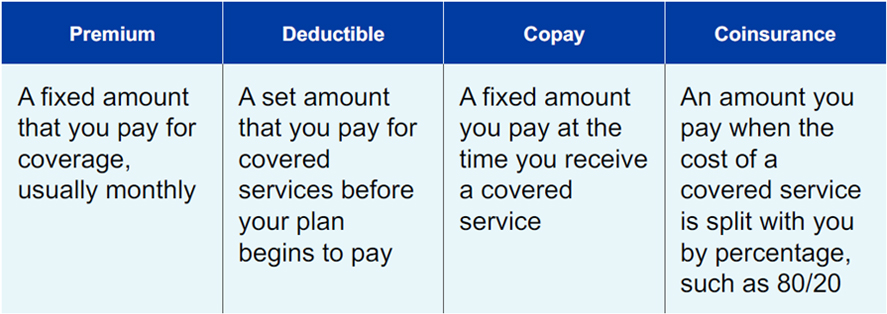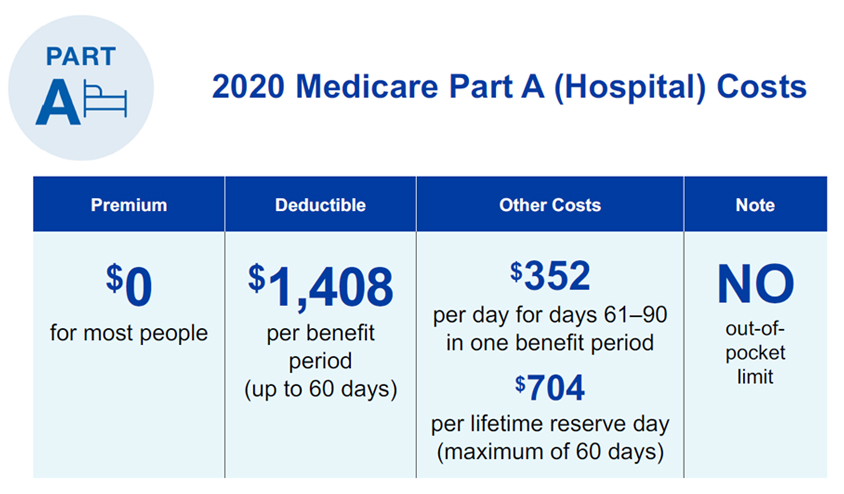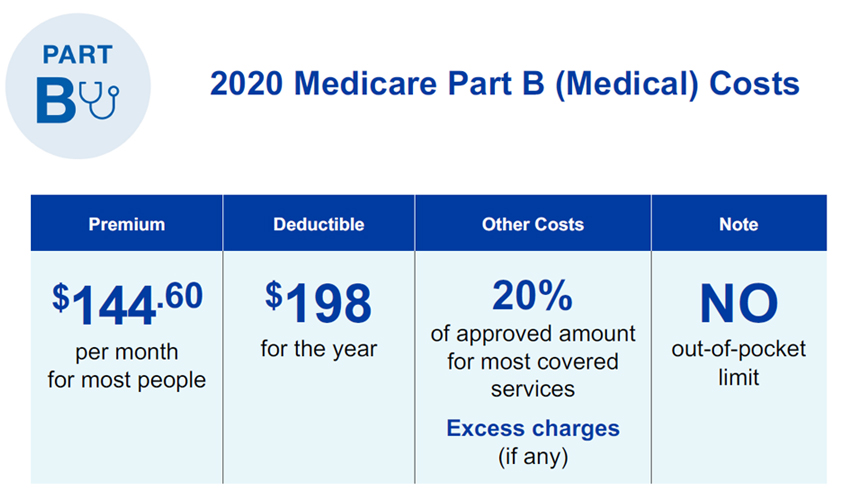How Much Does Medicare Cost?
HOW MUCH HAS MEDICARE COST YOU SO FAR?
Some would think that since you have paid into the Medicare fund all your working years, the cost of Medicare would be free, right? I mean, come on, you paid on average, 1.45% of your annual income into the Medicare fund and your employer matched that! If you were self-employed, then you paid both the employee and employer tax, for a total of 2.9%.
So, for the average American, you and your employer combined paid about $1,537 per year into the Medicare fund (assuming an average annual salary of $53,000). So how much does Medicare cost? Well, the Medicare tax started in 1966 at a smaller rate of 0.7%, so it is a little complicated to do the math, but Medicare has already costed you in the form of payroll taxes. Between you and your employer (after 40 years of employment), the total amount paid into Medicare on your behalf might be well over $40,000.
But I know that is not what you are asking.
HOW MUCH DOES MEDICARE COST
ONCE YOU ARE ENROLLED IN MEDICARE?
To answer this question, we need to understand a few terms:

We also need to understand that Medicare has two parts: Part A and Part B.
Cost of Part A:
If you (or your spouse) have worked in the U.S. for at least 10 years, then Part A does not have a monthly premium. But you will have deductibles and other costs if you end up in the hospital.

Cost of Part B:
Part B, however, does have a monthly premium. For most Americans, your Part B monthly premium (in 2020) will be $144.60. Higher income earners will have an income-related monthly adjustment.

These are the costs associated with Original Medicare. If you don’t want to be stuck paying the 20% that Medicare doesn’t cover (including deductibles and co-insurance), then you will also have the cost of a Medicare Supplement. You might also consider a Medicare Advantage plan. See our other blogs on the differences.
Cost of Part D:
In addition to your Original Medicare costs, you will also need to consider a Prescription Drug Plan (PDP). The average monthly premium for a Part D plan is $34 per month. You will also have deductibles and co-pays as well.
Examples
SCENARIO 1:
If you decide you want to stay on Original Medicare, and purchase a Medicare Supplement with a stand-along Prescription Drug Plan, here’s an example of what a 65 year-old Female, non-smoker, might pay each month (for the first year):
| Part B Premium | $144.60 per month |
| Plan G Supplement | $120.00 per month |
| Part D Plan | $34.00 per month |
| Total Monthly Premium | $298.60 per month |
In the above scenario, this client would pay an annual Part B deductible of $198 (for 2020) out of pocket as well. After that deductible is met, there will be no further medical expenses out of pocket (just the monthly premiums). There may also be deductibles and co-pays for prescription drugs.
SCENARIO 2:
If you decide you want to enroll in a Medicare Advantage plan, and you live in a major metropolitan area, like Maricopa County, then here’s what you might pay each month:
| Part B Premium | $144.60 per month |
| Medicare Advantage Plan | $0.00 per month |
| Part D Plan | $0.00 per month |
| Total Monthly Premium | $144.60 per month |
Now, in this scenario, you may not have a monthly premium for your Medicare Advantage plan, and most Advantage plans include your drug coverage as well. You will be responsible for co-pays as you use services. Every plan is different, and each service has a different co-pay. If you are super healthy, and never end up using services on a Medicare Advantage plan, then you will not have any out-of-pocket costs. Always talk with a licensed Medicare agent in your area to help you decide which plan might best fit your situation.
DETAILED MEDICARE COST FOR 2020:
Medicare Part A (Hospital Insurance) costs
Monthly premium: Most people don’t pay a monthly premium for Part A (sometimes called “premium-free Part A”). If you buy Part A, you’ll pay up to $458 each month in 2020. If you paid Medicare taxes for less than 30 quarters, the standard Part A premium is $458. If you paid Medicare taxes for 30-39 quarters, the standard Part A premium is $252.
Late enrollment penalty:
If you don’t buy it when you’re first eligible, your monthly premium may go up 10%. (You’ll have to pay the higher premium for twice the number of years you could have had Part A, but didn’t sign up.)
Part A costs if you have Original Medicare:
Home health care
- $0 for home health care services.
- 20% of the Medicare-approved amount for Durable medical equipment (DME).
Hospice care
- $0 for hospice care.
- You may need to pay a copayment of no more than $5 for each prescription drug and other similar products for pain relief and symptom control while you’re at home. In the rare case, your drug isn’t covered by the hospice benefit, your hospice provider should contact your Medicare drug plan to see if it’s covered under Medicare prescription drug coverage (Part D)
- You may need to pay 5% of the Medicare-approved amount for inpatient respite care.
- Medicare doesn’t cover room and board when you get hospice care in your home or another facility where you live (like a nursing home).
Hospital inpatient stay
- $1,408 deductible for each benefit period.
- Days 1–60: $0 coinsurance for each benefit period.
- Days 61–90: $352 coinsurance per day of each benefit period.
- Days 91 and beyond: $704 coinsurance per each “lifetime reserve day” after day 90 for each benefit period (up to 60 days over your lifetime).
- Beyond lifetime reserve days : all costs.
Mental health inpatient stay
- $1,408 deductible for each benefit period.
- Days 1–60: $0 coinsurance per day of each benefit period.
- Days 61–90: $352 coinsurance per day of each benefit period.
- Days 91 and beyond: $704 coinsurance per each “lifetime reserve day” after day 90 for each benefit period (up to 60 days over your lifetime).
- Beyond lifetime reserve days : all costs.
- 20% of the Medicare-approved amount for mental health services you get from doctors and other providers while you’re a hospital inpatient.
Skilled nursing facility stay
- Days 1–20: $0 for each benefit period.
- Days 21–100: $176 coinsurance per day of each benefit period.
- Days 101 and beyond: all costs.
Medicare Part B (Medical Insurance) costs
Monthly premium: The standard Part B premium amount in 2020 is $144.60. Most people pay the standard Part B premium amount. If your modified adjusted gross income as reported on your IRS tax return from 2 years ago is above a certain amount, you’ll pay the standard premium amount and an Income Related Monthly Adjustment Amount (IRMAA). IRMAA is an extra charge added to your premium.
Late enrollment penalty:
In most cases, if you don’t sign up for Part B when you’re first eligible, you’ll have to pay a late enrollment penalty. You’ll have to pay this penalty for as long as you have Part B. Your monthly premium for Part B may go up 10% of the standard premium for each full 12-month period that you could have had Part B, but didn’t sign up for it. Also, you may have to wait until the General Enrollment Period (from January 1 to March 31) to enroll in Part B. Coverage will start July 1 of that year.
Part B costs if you have Original Medicare:
Part B annual deductible:
In 2020, you pay $198 for your Part B deductible. After you meet your deductible for the year, you typically pay 20% of the Medicare-approved amount for these:
- Most doctor services (including most doctor services while you’re a hospital inpatient)
- Outpatient therapy
- Durable medical equipment (DME)
Clinical laboratory services:
- You pay $0 for Medicare-approved services.
Home health services:
- $0 for home health care services.
- 20% of the Medicare-approved amount for durable medical equipment (DME).
Medical and other services:
- You pay 20% of the Medicare-approved amount for most doctor services (including most doctor services while you’re a hospital inpatient), outpatient therapy, and Durable medical equipment (DME).
Outpatient mental health services:
- You pay nothing for your yearly depression screening if your doctor or health care provider accepts assignment.
- 20% of the Medicare-approved amount for visits to your doctor or other health care provider to diagnose or treat your condition. The Part B deductible applies.
- If you get your services in a hospital outpatient clinic or hospital outpatient department, you may have to pay an additional copayment or coinsurance amount to the hospital.
Partial hospitalization mental health services:
- You pay a percentage of the Medicare-approved amount for each service you get from a doctor or certain other qualified mental health professionals if your health care professional accepts the assignment. You also pay coinsurance for each day of partial hospitalization services provided in a hospital outpatient setting or community mental health center, and the Part B deductible applies.
Outpatient hospital services:
- You usually pay 20% of the Medicare-approved amount for the doctor or other health care provider’s services. For services that can also be provided in a doctor’s office, you may pay more for outpatient services you get in a hospital than you’ll pay for the same care in a doctor’s office. However, the hospital outpatient copayment for the service is capped at the inpatient deductible amount.
- In addition to the amount you pay the doctor, you’ll also usually pay the hospital a copayment for each service you get in a hospital outpatient setting, except for certain preventive services that don’t have a copayment. In most cases, the copayment can’t be more than the Part A hospital stay deductible for each service.
- The Part B deductible applies, except for certain preventive services. If you get hospital outpatient services in a critical access hospital, your copayment may be higher and may exceed the Part A hospital stay deductible.
Medicare Part D (Prescription Drug Coverage) costs
Monthly premium: The Part D monthly premium varies by plan (higher-income consumers may pay more).
Late enrollment penalty:
You may owe a late enrollment penalty if, for any continuous period of 63 days or more after your Initial Enrollment Period is over, you go without one of these:
- A Medicare Prescription Drug Plan (Part D)
- A Medicare Advantage Plan (Part C) (like an HMO or PPO) or another Medicare health plan that offers Medicare prescription drug coverage
- Creditable prescription drug coverage
In general, you’ll have to pay this penalty for as long as you have a Medicare drug plan. The cost of the late enrollment penalty depends on how long you went without Part D or creditable prescription drug coverage. Learn more about the Part D late enrollment penalty.
Deductibles, copayments, & coinsurance:
The amount you pay for Part D deductibles, copayments, and/or coinsurance varies by plan. Look for specific Medicare drug plan costs, and then call the plans you’re interested in to get more details.
CLEAR AS MUD?
These costs can be confusing.
Here at Insurance Professionals of Arizona, our licensed agents will be able to unwind the complexities of Medicare and can explain things in an easy to understand way.
Call us at 480-331-7974.
We’re here to help! Call us today.








Share your thoughts
Leave your comments